
About UsThe Numismatic Bibliomania Society is a non-profit organization promoting numismatic literature. For more information please see our web site at coinbooks.org SubscriptionsThose wishing to become new E-Sylum subscribers (or wishing to Unsubscribe) can go to the following web page link MembershipThere is a membership application available on the web site Membership Application To join, print the application and return it with your check to the address printed on the application. Membership is only $15 to addresses in the U.S., $20 for First Class mail, and $25 elsewhere. For those without web access, write to: David M. Sundman, Treasurer AsylumFor Asylum mailing address changes and other membership questions, contact David at this email address: dsundman@LittletonCoin.com SubmissionsTo submit items for publication in The E-Sylum, just Reply to this message, or write to the Editor at this address: whomren@gmail.com
BUY THE BOOK BEFORE THE COIN |
- WAYNE'S WORDS: THE E-SYLUM JULY 7, 2013
- NEWMAN COLLECTION SALE II HARDCOVER EDITIONS OFFERED
- NEW BOOK: ARAB-SASANIAN DRACHMAS
- NEW BOOK: GOLD IS THE KEY - ORDERING INFORMATION
- BOOK REVIEW: MATTE PROOF LINCOLN CENT DIES 1909-1916
- BOOK REVIEW: JOHN J. FORD AND THE FRANKLIN HOARD
- CHOPMARK NEWS JUNE 2013 ISSUE PUBLISHED
- I.A.P.N. 62ND ANNUAL CONGRESS
- CHIEF ENGRAVER WILLIAM KNEASS
- BILL SEEKS LIBERTY-THEMED CIRCULATING COINAGE
- NOTES FROM E-SYLUM READERS: JULY 7, 2013
- QUERY: INSCRIBED TAXAY BOOKS ON COUNTERFEITS SOUGHT
- QUERY: CATALOG NUMBER FOR 2012 WILDMAN COIN SOUGHT
- QUERY: 1768 ROYAL ACADEMY MEDAL DESIGN SOURCE SOUGHT
- J. V. MCDERMOTT AND HIS 1913 LIBERTY HEAD NICKEL
- DAVID RITTENHOUSE PRESIDENTIAL APPOINTMENT DOCUMENT
- U.S. MINT EMPLOYEE RITTENHOUSE MEDALS
- QUERY: KENTUCKY HORSESHOE TOKEN INFORMATION SOUGHT
- PETER IRION ON TOKEN AND MEDAL BOOKS YET TO BE PUBLISHED
- DICK JOHNSON ON TOKEN AND MEDAL BOOKS YET TO BE PUBLISHED
- DAVID O'KEEFE AND YAP STONE MONEY
- FAIRBANKS, ALASKA CARNIVAL MONEY
- THE DANDELION DOLLAR
- THE FORT SUMTER GILLMORE MEDAL
- THE 1864 STONEWALL JACKSON MEDAL
- THE FERRACUTE MACHINE COMPANY
- ERIC THE RED LIFESAVING MEDAL ON DISPLAY IN WARRNAMBOOL
- NANOTECHNOLOGY BRINGS BUTTERFLY COLORS TO CURRENCY
- ARTICLE PROFILES CANADIAN COIN DESIGNER JOHN HORTON
- ROYAL MINT TO ISSUE SILVER PENNY FOR ROYAL BIRTH
- SCOTTISH FESTIVAL CLEANUP CREW FINDS COIN HOARD
- SOME NEW COIN DESIGNS: JULY 7, 2013
- DEWEY DECIMAL JEWELRY
- KENYAN PICKPOCKETS PROTEST CASHLESS TRANSACTIONS
- FEATURED WEB PAGE: DATES ON MODERN SPANISH PESETA COINS
WAYNE'S WORDS: THE E-SYLUM JULY 7, 2013

We have no new subscribers this week. We have 1,659 email subscribers, plus 236 followers on Facebook.
Jim Wells and other subscribers have been trying to work through AOL to resolve the problem with receiving their E-Sylum issues. Jim even got someone on the phone. If you are an AOL subscriber, please reply and let me know if you got this issue. Thanks.
This week we open with word on the catalogs for the second sale of the Eric P. Newman collection, three new books, and a report on the recent IAPN Congress.
Other topics include chopmarked coins, Carnival money, Mint Director David Rittenhouse, engraver William Kneass, dealer J.V. McDermott, and Civil War medals for Fort Sumter and Stonewall Jackson.
To learn more about Matte Proof Lincoln cents, Wildman coins, Boloney money, heavy metal, nanotechnology, biomimicry, and token and medal books yet to be published, read on. Have a great week, everyone!
Wayne Homren
Editor, The E-Sylum
NEWMAN COLLECTION SALE II HARDCOVER EDITIONS OFFERED
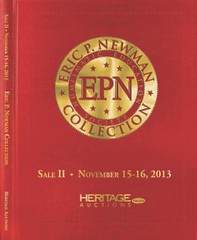 The second sale of selections from the Eric P. Newman Numismatic Society (EPNNES) collection will feature Federal U.S. coinage from two cent pieces through early silver dollars, including early silver rarities pedigreed to the Col. E.H.R. Green collection and a number of Bust quarter dollars from the extraordinary collection originally formed by Ard W. Browning.
The second sale of selections from the Eric P. Newman Numismatic Society (EPNNES) collection will feature Federal U.S. coinage from two cent pieces through early silver dollars, including early silver rarities pedigreed to the Col. E.H.R. Green collection and a number of Bust quarter dollars from the extraordinary collection originally formed by Ard W. Browning.
Sale II will be held on November 15-16, 2013 at the Fletcher-Sinclair mansion, 2 East 79th Street and Fifth Avenue, New York, New York by Heritage Auctions.
Special Hardcover Editions of Sale I are in and already on their way to advance subscribers. Subscribe to the Special Hardcover Editions of these historic sales today to ensure you don't miss one issue. Subscribe on our secure site at numislit.com
The Eric P. Newman Numismatic Education Society will receive $25 from the sale of every catalogue to further its philanthropic activities, including the advancement of numismatic scholarship.
Subscription cost is $95 per catalogue plus $5 U.S. postage, charged when each copy is shipped. Foreign customers will be charged actual shipping cost.
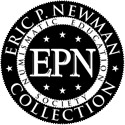 Heritage Auctions has designated the week of Nov. 11-16, 2013, as "Newman Week in New York City" to honor the legacy of esteemed numismatic researcher, author and collector Eric P. Newman, culminating on the evenings of Nov. 15 and 16 with the second eagerly anticipated offering of numismatic rarities from Newman's legendary collection. Most of these outstanding historic coins have been off the market for a half century or more.
Heritage Auctions has designated the week of Nov. 11-16, 2013, as "Newman Week in New York City" to honor the legacy of esteemed numismatic researcher, author and collector Eric P. Newman, culminating on the evenings of Nov. 15 and 16 with the second eagerly anticipated offering of numismatic rarities from Newman's legendary collection. Most of these outstanding historic coins have been off the market for a half century or more.
The "Selections from The Eric P. Newman Collection Part II" auction will be conducted by Heritage, live and online, at the Fletcher-Sinclair Mansion (2 E. 79th Street, at 5th Avenue) in New York City, Nov. 15 and 16, 2013. Lot viewing of the collection will take place from Monday, Nov. 11 to Thursday, Nov. 14, at Heritage's 445 Park Avenue offices, on the 15th floor.
"Part I this past April brought more than $4 million in winning bids for 159 pattern coins from Newman's remarkable collection," said Jim Halperin, Co-Chairman of Heritage Auctions. "Part II this fall will feature more than 1,800 early American and 19th century U.S. coins with an estimated combined value of $15 million or more."
The auction will include a broad selection of U.S. quarters, half-dollars and silver dollars, as well as high-grade two-cent and three-cent pieces, nickels, dimes and twenty-cent pieces.
"Many of these historic treasures have been in Newman's possession since he obtained them directly from the estate of another legendary collector, Colonel E.H.R. Green, more than 70 years ago," said Halperin.
Specific information about the coins to be offered in Part II will be announced by Heritage in the coming months.
Newman, 102, is a retired St. Louis lawyer and business executive who is well-known in numismatics as a collector, researcher and award-winning author. He began collecting at the age of seven, and today is the only surviving person to ever own all five of the fabled 1913 Liberty Head nickels.
Items being sold are from the extensive collection of the Eric P. Newman Numismatic Education Society (a Missouri not-for-profit corporation) and have been assembled over a period of 90 years. Proceeds of the sale of all items will be used exclusively for supplementing the Society's museum operations and scholarly research efforts and for the benefit of other not-for-profit institutions selected by the Eric P. Newman Numismatic Education Society for public purposes.
NEW BOOK: ARAB-SASANIAN DRACHMAS
 Ernst Günther Weber, Arab-Sasanian drachms, in: Contributions to Bremen Coin and History, ed: Bremer Numismatic Society. , 2013. 120 pages, color illustrations throughout. A4. Paperback. Sewn binding. 24 € plus shipping.
Ernst Günther Weber, Arab-Sasanian drachms, in: Contributions to Bremen Coin and History, ed: Bremer Numismatic Society. , 2013. 120 pages, color illustrations throughout. A4. Paperback. Sewn binding. 24 € plus shipping.
In the year 77 of the Hegira (696 AD) decided to set in motion a major coinage reform of the Umayyad ruler Abd al-Malik. Until then had been used Arabic silver coins modeled on the Sasanian drachmas, the traditional symbols showed that remotely stood Islam, even partially incompatible with the new embassy were. Only small Arabic inscriptions pointed to the new Coin Lords and its revolutionary world view. This highly interesting testimony of one of the most important eras of human history with coin collectors are still a little in the shade. This is a great opportunity for willing to learn, as there are still unique and great rarities for little money on the market have.
One who has grabbed this opportunity with both hands, Ernst Günther Weber. He has his collection is now in the 8th Band of Bremen contributions to the coin and story published. And it is a remarkable collection. It consists of 208 pieces, minted between 651/2 and 793 / 4th Hidden therein are 20 unike and some extremely rare coins he makes the science accessible with this.
The centerpiece of the book is the extensive publication of the collection. Each coin is illustrated with diameter and weight, the signature appearing thereon is reproduced and resolved. The four major reference works are cited. For this purpose, the author comments on the pieces that have found their special attention in detail. Catalog The author sends a three-sided, translated into English Introduction ahead, in which he responds to short abbreviations, his system of transliteration and the annual figures. Useful is his statement to that of the designs, which also allows the inexperienced, to find a provision for central points of the coin.
On a historical introduction, the author omitted because - quite rightly - notes that this is to be found in the works of John Walker, Heinz Gaube and the latest catalog of the Ashmolean Museum also. But Walker and dormer wrote in 1967 and 1973, and the Sylloge the Ashmolean Museum in 2002 are unfortunately published in the English language, making it the German reader would have been glad if he is also in German about the current state of research could inform.
In Appendix gives the author nor a summary of the equivalent temples to the drachma, and summarizes in tabular form the coins in the collection together. The big surprise comes when one considers the price of this important guide to the Arab-Sasanian coinage: 24 € plus shipping costs - 2 € at home 6 euros abroad. Because you have to speak of a nominal fee are more likely.
The Bremen Numismatic Society has once again enriched the numismatics. Purchase can book on Auctions & coin dealers, Christoph Stadler K. a post about the great coinage reform of Abd al-Malik can be found here: muenzenwoche.de/de/Die-erste-islamische-Goldmuenze-der-Geschichte/8?&id=71&type=a
To read the complete article, see: Arab-Sasanian drachmas - The latest volume of the Bremen contributions to the coin and history (www.muenzenwoche.de/de/News/4?&id=2105)
NEW BOOK: GOLD IS THE KEY - ORDERING INFORMATION
Last week we published an excerpt from a Paper Money article by Terry Bryan relating to a book about a bank robbery of the Jackson, Tennessee branch of the Union Bank in 1859. Terry put me in touch with author Tom Aud, who writes:
My publisher can be contacted at www.braybreepublishing.com and people can order it from Amazon.com or from me directly at tomaud@gmail.com. Prices vary from different sources but the book lists for $25.00. It has been well received and I believe that coin collectors especially would enjoy it
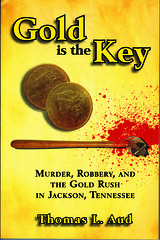 Gold is the Key:
Murder, Robbery, and the Gold Rush in Jackson, Tennessee
Gold is the Key:
Murder, Robbery, and the Gold Rush in Jackson, Tennessee
Author: Thomas L. Aud
ISBN-13: 978-0-9671251-3-8
Format: 6 x 9 Trade Paperback
Pages: 282
Price: $25.00
BrayBree Publishing Company LLC announces the release of Gold is the Key: Murder, Robbery, and the Gold Rush in Jackson, Tennessee, a new book by Madison County Archivist Thomas L. Aud.
In 1985, the discovery of a mysterious cache of gold coins led to gold fever in Jackson, Tennessee. City workers who had unearthed the 300 nearly-mint coins quickly cashed them in at local banks or exchanged them for jewelry. One person even traded them for a used car. There was an investigation by the Jackson Police Department to determine the rightful owners and a lawsuit by the City of Jackson against those who had obtained the coins. But in the end, the mystery still remained: who actually buried the gold coins and why?
At the time, Aud worked for the Jackson-Madison County Library. With the question of ownership of the gold coins prevalent, he researched property records and discovered past owners of the place the coins were found, but found no answers. The mystery led him to dig deeper over the next 25 years and explore the possibility that they were linked to an unsolved robbery of the Jackson branch of the Union Bank of Tennessee and the murder of its clerk, George E. Miller, in February 1859. The results of his research are presented in Gold is the Key: Murder, Robbery, and the Gold Rush in Jackson, Tennessee.
The 28-year-old Miller lived in the bank building located on East Baltimore Street where the New Southern Building stands today. There his body was discovered on the morning of February 4, 1859, having been hit over the head with a canceling hammer he had used in banking business. Missing from the vault were $17,300 in paper notes and $5,700 in gold coins. Over the years, there were suspects whose guilt could never be proven and individuals claiming to know the whereabouts of the gold coins who offered their knowledge in exchange for a reward. But the murderer (or murderers) was never found and the coins were never recovered.
Aud is confident the buried coins are linked to the robbery of the Union Bank and the murder of George Miller. “All the coins found in 1985 predated the bank robbery and murder in 1859 and many were in good or better condition, which indicated to coin collectors that they could have been taken from a bank,” he said. “If the coins had been stashed away by a land owner in advance of or in reaction to the occupation by Union soldiers during the Civil War or a national depression, logically there would have been coins more recent than 1858 included.”
Gold is the Key: Murder, Robbery, and the Gold Rush in Jackson, Tennessee is available on BrayBree Publishing’s website: braybreepublishing.com
For more information, or to order, see: Gold is the Key: Murder, Robbery, and the Gold Rush in Jackson, Tennessee (braybreepublishing.com/books/goldisthekey/)
BOOK REVIEW: MATTE PROOF LINCOLN CENT DIES 1909-1916
 A Collector’s View of Matte Proof Lincoln Cent Dies 1909-1916
A Collector’s View of Matte Proof Lincoln Cent Dies 1909-1916
By Carl B Waltz, Jr., Book Review by Richard C. Jewell, Clarion Editor
Carl B. Waltz, Jr. has published a photographic journey through his ANA & PAN award winning exhibit Matte Proof Lincoln Cent Dies 1909-1916.
The author starts off by announcing that he is not an expert in the subject matter but goes on to expertly explain and diagram in detail the process of matte proofing and the distinct differences in each year’s application.
If he is not an expert in the field he is certainly the next best thing….an individual with extraordinary knowledge and perception in clarification of a particular subject matter. Darn if that doesn’t sound like an expert to me!
This spiral bound, color, 135 page opus begins with an introduction that describes his inspiration for the book came from some encouragement he received after exhibiting his Matte Proof Lincoln Cents at the ANA, Philadelphia convention in the summer of 2012. In particular he gives credit to both Leonard Albrecht and J.T. Stanton for encouraging him to put pen to paper and photos to page.
The focus of the book is to show in detail the die diagnostics of the Matte Proof Lincoln Cent.
Photographs, all taken by the author, vividly display the variations in surface grainy, satin-like finishes, rim differences, obverse die details and reverse die details, and generally why matte proofs show much more detail of the design than business strikes. The author uses a ubiquitous yellow arrow, to gain attention and dramatize his specific points of interest.
The limited dialogue at the beginning of each chapter highlights the number of Matte Proofs issued in each year, the number of obverse and reverses dies utilized and a quick observation to that particular issue, whether it’s a deep matte surface or a sharp strike or a more satiny finish, etc.
For those of you who are Matte Proof Lincoln Cent collectors this is the book you have been waiting for. As far as those collectors who are less inclined this pictorial journey might just peak your interest enough to start your study into a very interesting and challenging numismatic collection.
The book can be purchased for $30.00 from book dealer John H. Burns at your local coin show or by contacting him via the internet at johnhburns@comcast.net. It is also available from the author postage paid for $35.00. The address is Carl Waltz, PO Box 62, Millersville, PA 17551.
THE BOOK BAZARRE
BOOK REVIEW: JOHN J. FORD AND THE FRANKLIN HOARD
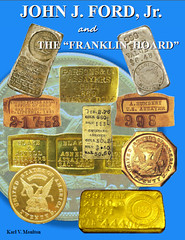 I must admit to having placed Karl Moulton's massive 900 + page John J. Ford, Jr. & Paul Franklin book aside after perusing it for a short while upon receipt some three weeks ago. Gad, how was I going to be able to get through this tome with all my other activities?
I must admit to having placed Karl Moulton's massive 900 + page John J. Ford, Jr. & Paul Franklin book aside after perusing it for a short while upon receipt some three weeks ago. Gad, how was I going to be able to get through this tome with all my other activities?
Well, the other day I finally picked it up and read it for several hours over several days while sitting in front of the TV... not really watching . A really easy read and a fascinating one. As is often my pattern, I will read such a book in sections, not necessarily in order. The Moulton text is not at all complex or profuse. Indeed, the easy majority of the 900+ pages is composed of plates of suspicious and "pioneer territorial" items and letters between Ford and other dealers and Ford's many private buyers - the latter mostly wealthy and highly educated collectors , some of whom I knew well like Henry Clifford of Pasadena.
Which brings me to explain the presence of the 1982 Bowers and Ruddy Henry Clifford Los Angeles auction catalogue of Western pioneer and territorial numismatic coins, patterns and ingots, mass-shipped along with the book itself (an auction I attended) . This was clearly an intentional act by Moulton as it reflects just how much of this famous auction offering was of spurious ingots, patterns and trial strikes. A startling percentage of the collection !
Clearly, no other auction offering in numismatic history contained nearly as high a percentage of suspect expensive items as this sale did. It is fascinating to cross-reference the profuse Clifford/Ford correspondence illustrated in the book with the auction catalogue. Clifford was undoubtedly the biggest buyer of this material. Yet Clifford, ironically an investment counselor, was a thorough researcher and would not buy an item without establishing the historical background of the item and even its metallic alloy content.
This is what Ford and Paul Franklin were masters at. Franklin physically made these items of silver and gold alloy of the period and region (easily done by melting nuggets or common coins of the period and region) while Ford thoroughly researched the historic background of the coiners and assayers. Franklin designed the items in conjunction with Ford's advice and Ford was the salesman, finding and persuading his buyers of the items' legitimacy.
Ford was a very convincing salesman, with his deep baritone voice, six-foot stature and his infinite knowledge of the Old West. Indeed, he extensively advertised during this 1950-80 period for such items, apparently convincing buyers and intermediary dealers that such a profuse and constant availability of these items was the result of his advertising, most often through the respected publications and auction catalogues of Charles Wormser's New Netherlands Coin Co. Charles Wormser, unlike his father Moritz, was not an accomplished numismatist and clearly yielded to the whims and demands of his employee. Charles is free of any suspicion. I knew him. Almost a "babe in the woods".
Also covered in the Moulton book: Ford was also an accomplished trader and very convincing in his private numismatic transactions. Here it is clear that "knowledge is king" as we know so well today. More than once Ford was able to convince an owner of a valuable and rare coin that the traces of die rust or the superb condition of a rarity must be indicative of a restrike, such as with his much-litigated acquisition of one of the four original 1861 Confederate silver half dollars.
He was also convincing in quoting the recent sale price of a markedly inferior gold coin when trying to acquire a Gem Uncirculated specimen...in an era where superb condition was not nearly as important or impactful on price as it is today. This first came to the auction fore with the 1958 New Netherlands sale of Elliot Landau's collection who, according to author Ford in that catalogue, did pay well over "market-value" for superb condition, well above middle grade condition pieces. Collector Landau is addressed in the Moulton book (I own Landau's Gem Unc 1792 half disme).
All this is apparent throughout the Moulton book and it is a pleasant and easy read if done in segments over perhaps less than a week. The book is not for the Franklin half full bell lines, Mercury dimes split bands and slab grader "numismatists" so prevalent on the PCGS Coin Forum or in our hobby today. This book is for more accomplished numismatists. But it is not technical or a difficult read at all. It is a pleasant and enthralling travel through numismatic time 1950-80 or so - easily on par with the best of Dave Bowers' nostalgic books.
One thing shocked me and still deeply impresses me more than anything else in the book: Author Moulton was able to acquire and print full size in its entirety a letter typed up in 1891 with its original mailing envelope. Although unsigned, it is clearly the product of John J. Ford, Senior- JJF Jr's father. It originates from a New York City address in proximity to JJF, Jr.s address and before Senior moved to Los Angeles where Jr was born. It discusses in detail the Senior's planned sale of counterfeit US currency. The pattern of typing, the speech used, the paragraph spacing, the strong personality behind the words...if I didn't know the 1891 origin date, I would have thought this was typed by JJF Jr. Over the decades I rec'd many such typed missives from JJF Jr and many more are illustrated in the Moulton book. Through this 1891 letter, it is remarkable how alike Senior and Jr were in personality and apparent character. The old adage "the fruit doesn't fall far from the tree" was never truer. I wonder if there was a physical similarity and suspect so.
It is also clear that the intermediary dealers who handled and sold many items for JJF, Jr were as taken in as the clients they served, convinced by Ford's research behind the coin or ingot, his personality and extensive advertisements and knowledge of the Old West that the items were all legitimate. Sure, the constant flow of such items over years could have raised alarms, but by then Ford seemed to have the field "tied up" with his reputation.
Clearly, such reputable dealers would not have intentionally sold such items to wealthy long term clients and eventually into the Smithsonian itself or constructed an impressive auction catalogue for all the world to see if they had an inkling of the true nature of the material. Even Congress in the late 1960's in considering the Lilly estate $5.5M tax credit deal exchange with the Smithsonian ignored the warnings that many of the collection items were clearly suspect. I was there and so testified. Not much change in Congress today.
In summary, a well put together book, a fascinating and easy read and a thorough glimpse into American numismatics of the 1950-80's period. And a character study of perhaps American numismatics' most intriguing rogue.
To read an earlier E-Sylum article, see: BOOK REVIEW: JOHN J. FORD AND THE FRANKLIN HOARD (www.coinbooks.org/esylum_v16n26a07.html)
For more information, or to order, see: NEW BOOK: JOHN J. FORD, JR., AND THE FRANKLIN HOARD (www.coinbooks.org/esylum_v15n53a04.html)
CHOPMARK NEWS JUNE 2013 ISSUE PUBLISHED

-
 Editor’s Note
Editor’s Note
- Donations
- New Members
- Announcement
- Letters
- Meet our Members: Conrad Frost
- Coins from the Conrad Frost Collection
- From Our Members’ Collections
- Article: Decoding the Mystery of the Philip-pine Countermark Pearl Formation By: E. Yap
- Recent Sales
- Article: The British Trade Dollar By: K. Clancy
- The British Trade Dollar—pictures
- The Interview: Paul Van Dyke
- Obituary: Richard Doty
For more information on the Chopmark Collectors Club, see: http://chopmarks.org
I.A.P.N. 62ND ANNUAL CONGRESS
The International Association of Professional Numismatists (I.A.P.N.) held its 62nd General Assembly in Leipzig, Germany, in May of 2013. A total of thirty four of the world’s leading numismatic firms met to attend the congress, with an additional twenty six firms represented via proxy. It was the first time the congress was conducted in the Eastern part of Germany.
The I.A.P.N. Congress’ program comprised a wide range of topics, such as the applications for new membership. Of the applicants, two new firms were voted into the I.A.P.N. as members: Marti Hervera, Spain, and London Coins Ltd (Stephen Lockett), Great Britain.
Several other important topics were discussed as well, including reports from the various sub committees. The I.A.P.N. has been working diligently on several developments within the numismatic industry to better the hobby. This includes the establishment of the “Committee on International Trade” which presented an elaborate report on issues pertaining to import and export laws as well as cultural property laws. The committee is working to preserve the rights of collectors within the numismatic community.
Reports were also given by IBSCC and of the Anti Forgery Committee. The topic of forgeries within the market place is no stranger to these meetings. The IBSCC and Anti Forgery Committees meet regularly to discuss and combat these issues. Over the past year the Anti Forgery Committee has met three times since the last congress in Jerez de la Frontera Spain in 2012. During this period of time, members of the committee examined and deliberated on several numismatic items, several of which were declared to be forgeries or non-contemporary issues.
 As usual, the I.A.P.N. also presented its annual book prize. Although many good books were submitted, this year’s winners were Ronachai Krisadaolarn and Vasilius Mihailovs for their work on Siamese coins.
As usual, the I.A.P.N. also presented its annual book prize. Although many good books were submitted, this year’s winners were Ronachai Krisadaolarn and Vasilius Mihailovs for their work on Siamese coins.
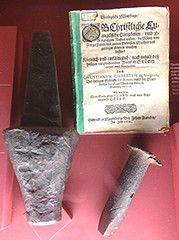 Congress participants were happy to attend a series of tours in Leipzig and the surrounding cities, filled with historical numismatic information. In the Museum of Municipal History in Leipzig’s Old City Hall, for example, the wedding ring of Katharina von Bora, wife of the reformer Martin Luther, could be seen. The museum also has a coin cabinet where a wide variety of rare coins and medals from Saxony is exhibited; the presentation also includes an early set of dies used for hammered coinage. The University of Leipzig was also visited which houses some 82,000 numismatic items.
Congress participants were happy to attend a series of tours in Leipzig and the surrounding cities, filled with historical numismatic information. In the Museum of Municipal History in Leipzig’s Old City Hall, for example, the wedding ring of Katharina von Bora, wife of the reformer Martin Luther, could be seen. The museum also has a coin cabinet where a wide variety of rare coins and medals from Saxony is exhibited; the presentation also includes an early set of dies used for hammered coinage. The University of Leipzig was also visited which houses some 82,000 numismatic items.
The I.A.P.N. general assembly for 2014 is scheduled to be held in Monte Carlo, Monaco.
David Fanning writes:
Kolbe & Fanning are proud to be members of IAPN, and I was able to attend the recent Congress in Leipzig. The Congress was very ably organized by the Höhn family of Leipziger Münzhandlung, who kept the dozens of participants busy and entertained. In addition to various tours and social gatherings, meetings were held to discuss such topics as the regulation of worldwide trade and new efforts to combat the proliferation of counterfeits.
As has already been mentioned in The E-Sylum, we awarded the first prize book award to Siamese Coins from Funan to the Fifth Reign by Ronachai Krisadaolarn and Vasilijs Mihailovs. The Congress was productive and worthwhile, and quite enjoyable as well. We're all looking forward to next year's Congress in Monaco.
To read the complete article, see: I.A.P.N. 62nd Annual Congress (www.coinsweekly.com/en/News/4?&id=2099)
For more information on IAPN, see: www.iapn-coins.org
CHIEF ENGRAVER WILLIAM KNEASS
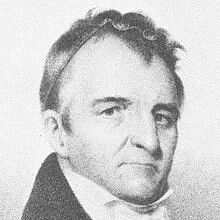 Regarding the inquiry about William Kneass, I don’t believe there is a single source for his letters and other archival information. However, there are several institutions where some historical documents of Kneass can be located. William Kneass is mentioned in the “William Wood Thackara Diary” at the Historical Society of Pennsylvania, along with an article by Robert Crompton that draws from the Diary, “ James Thackara, of Lancaster and Philadelphia, Engraver Journal of the Lancaster County Historical Society, Volume 62, Number 2, (April, 1958). Other sources include the Library Company of Philadelphia, the New York State Library, the Smithsonian, and the National Archives and Records Administration in Philadelphia, where the early US Mint records are located. More archival information could be found by researching the papers of the publishers that Kneass worked for.
Regarding the inquiry about William Kneass, I don’t believe there is a single source for his letters and other archival information. However, there are several institutions where some historical documents of Kneass can be located. William Kneass is mentioned in the “William Wood Thackara Diary” at the Historical Society of Pennsylvania, along with an article by Robert Crompton that draws from the Diary, “ James Thackara, of Lancaster and Philadelphia, Engraver Journal of the Lancaster County Historical Society, Volume 62, Number 2, (April, 1958). Other sources include the Library Company of Philadelphia, the New York State Library, the Smithsonian, and the National Archives and Records Administration in Philadelphia, where the early US Mint records are located. More archival information could be found by researching the papers of the publishers that Kneass worked for.
From my research on Robert Scot, I also found the following information on the early engraving career of Kneass, from contemporary sources. In July of 1796, William Kneass became apprenticed to Philadelphia engraver James Thackara, who had just ended his six year engraving partnership with John Vallance, a Scottish immigrant. Thackara had been trained in engraving by Robert Scot and James Trenchard. It is probable that Kneass assisted with some of the 18 engravings that Thackara completed and signed for Thomas Dobson’s Encyclop¿dia during 1796 and 1797.
The first engravings signed by William Kneass were in 1802 for The Poetical Works of Oliver Goldsmith, published by Thackara. He also engraved Freemasonry illustrations including the Grand Lodge of Philadelphia. From 1806 to 1821, Kneass contributed many engravings for the American edition of Abraham Rees’ The New Cyclop¿dia, initially published by Samuel F. Bradford. Prior to his appointment as Chief Engraver at the US Mint, Kneass completed a large volume of engraving work, primarily copperplate illustrations. More research is needed on these early US Mint engravers to gain knowledge of the contributions they made to early American publishing.
To read the complete article, see: QUERY: PAPERS OF CHIEF ENGRAVER WILLIAM KNEASS SOUGHT (www.coinbooks.org/esylum_v16n27a16.html)
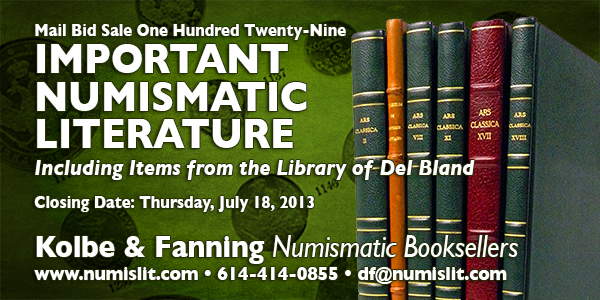
BILL SEEKS LIBERTY-THEMED CIRCULATING COINAGE
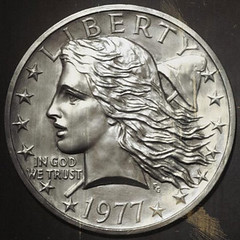 The Citizens Coinage Advisory Committee (CCAC) has long recommended to Congress the idea of creating a series of circulating coins featuring new depictions of Liberty. After years of inaction by Congress, several CCAC members recently became much more vocal advocates of the program, and it seems that these recent efforts have finally done the trick.
The Citizens Coinage Advisory Committee (CCAC) has long recommended to Congress the idea of creating a series of circulating coins featuring new depictions of Liberty. After years of inaction by Congress, several CCAC members recently became much more vocal advocates of the program, and it seems that these recent efforts have finally done the trick.
On June 27, 2013, a bill was introduced in the House of Representatives which seeks to authorize the American Liberty Commemorative Coinage Program. Broadly, the program would include the issuance of dimes, quarters, and half dollars with designs emblematic and allegoric of the concept of American Liberty. The new proposal overcomes some of what may have been considered the sticking points of the previous attempts and strongly positions the program as an opportunity to reduce the Federal deficit.
Previous proposals by the CCAC had called for the inclusion of the cent and nickel within the denominations to carry new Liberty-themed designs. Since these two denominations cost more than their respective face values to produce, any increased demand for these coins would essentially result in a reduction in overall seigniorage generation. With the cent and nickel removed from the new proposal, any incremental coin production would directly increase seigniorage.
Previous proposals have also called for the annual Liberty themed design to temporarily displace the current Presidential portrait which appears on the denomination. There is typically dissent or controversy which result from any attempts to displace a President from coin or currency. The new proposal specifically calls for the design featuring the Presidential portrait to be issued concurrently with the Liberty design.
The dime and quarter dollar would alternate annually in featuring the new Liberty themed designs, beginning with the dime in 2015. The obverse designs would be emblematic and allegoric of the concept of American Liberty.
To read the complete article, see: Bill Seeks American Liberty Themed Circulating Coinage (mintnewsblog.com/2013/07/bill-seeks-american-liberty-themed-circulating-coinage/)
NOTES FROM E-SYLUM READERS: JULY 7, 2013
Silver Coins: Where Did They Go and Why
Last week Dave Ginsburg asked about the 1984 DeAndrea book entitled "Silver Coins: Where Did They Go and Why". Justin Perrault writes:
Although I do not have a copy of this book myself, it would appear that a couple of copies are available for purchase through AbeBooks and Amazon. Here is the link to the results: http://tinyurl.com/m6455v7
At 76 pages in length, it is a relatively short title. Kind of an interesting piece of history though considering this came out following silver's last big heyday in the early 1980's.
Fred Lake writes:
Vincent F. DeAndrea's book "Silver Coins: Where did they Go and Why" appears in Lake Books July 23, 2013 sale at lot J31. It was copyrighted in 1984 and details the coin shortage of 1963-1965 and presents some detail of the years 1959 to 1972. The book has 79 pages and is full of charts and graphs. You can view the sale at http://www.lakebooks.com/current.html
To read the earlier E-Sylum article, see: NOTES FROM E-SYLUM READERS: JUNE 30, 2013 : Query: DeAndrea Book on Silver Coins (www.coinbooks.org/esylum_v16n27a12.html)
A New Reader is Wowed
Daryl Haynor writes:
I received my first E-Sylum publication, and spent some time the last couple of days perusing the archives. All I can say is Wow. That you publish so much information on a weekly basis while, I assume, still holding your real day job is astonishing and already much appreciated.
Query: Article on 1904 El Salvador Pesos Sought

Roberto Jovel of Chile writes:
I am trying to locate an article by Didier Vanoverbeek on the 1904 issue of El Salvador Pesos or Colones at the Hamburg Mint. I searched The E-Sylum without success. Would anyone have any suggestions as to where else I may search? Many thanks in advance for any advice on this matter.
As we understand it, 150,000 of those coins were minted in Hamburg and 450,000 in Brussels, both in 1904. I sincerely hope someone can remember the article I am interested in.
On Bronze Powder and Electrotyping
Paul Schultz writes:
I perhaps shouldn't be picky, but Dick Johnson was in error when he stated "Bronze powder must be used. It is pure copper." Bronze is an alloy of copper with other elements, most commonly tin, but which could also include aluminum and lead. Zinc can be present in a bronze provided that other alloy elements are present. Plain old copper and zinc with no other elements is classified as brass (although old fashioned names for specific alloys can seem to contradict that definition).
To read the earlier E-Sylum article, see: LEAD COUNTERFEITS, MAGNETS AND MAKING ELECTROTYPES (www.coinbooks.org/esylum_v16n27a19.html)
V. M. Hanks' Lincoln Connection
Karl Kabelac writes:
In the note about V. M. Hanks two weeks ago, it mentioned that he was proud to be a direct descendant of Nancy Hanks and in his obituary which was reprinted in last week's issue it mentioned that he was a descendant of Abraham Lincoln. I do not see how either could be true. Although I do not know the Hanks line, I wonder if he was a collateral descendant of Nancy Hanks and thus a cousin of Abraham Lincoln.
To read the earlier E-Sylum article, see: VIRGIL MCKNIGHT HANKS, JR. (www.coinbooks.org/esylum_v16n26a15.html)
QUERY: INSCRIBED TAXAY BOOKS ON COUNTERFEITS SOUGHT
George Kolbe writes:
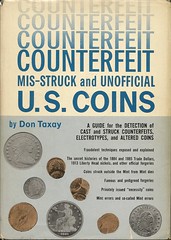 I would like to be contacted by anyone who possesses an inscribed first edition, April 1963 first printing of Don Taxay's "Counterfeit, Mis-Struck, and Unofficial U.S. Coins."
I would like to be contacted by anyone who possesses an inscribed first edition, April 1963 first printing of Don Taxay's "Counterfeit, Mis-Struck, and Unofficial U.S. Coins."
The book's dust jacket must be present and the title or endpapers should by inscribed by John J. Ford, Jr., Don Taxay, or someone involved with the publication of the book, including its designer, Fred Honig.
Some of the Taxay volumes possessing these criteria may be particularly desirable and I will share with respondents my findings.
Anyone else have one matching George's criteria? He can be reached at gfk@numislit.com . -Editor
QUERY: CATALOG NUMBER FOR 2012 WILDMAN COIN SOUGHT


I saw, in the last issue of The E-Sylum, a notice of the 2014 Standard Catalog of World Coins 2001-Date. Could someone advise me what, if any, KM number has been assigned to the Finland 5 euros 2012 for Lapland? It was issued in uncirculated and proof. I have the coin, but I don’t, yet, know what number for it to put in my file.
The coin (or NCLT?) is the most recently issued item to be issued with the wildman in which I specialize. I also have the similar 2011 5 euros with the same wildman but a different obverse. It was, I was told, assigned KM-170.
The wildman on the 2012 and 2011 versions are identical - and just so-so wildmen. They are, however, the only recent coins or medals with wildmen (that I know about) so I include them in my list of all the “Wildmen Of the World” - hoping to eventually publish it somewhere/sometime. My question is what, if any, KM number has been assigned to this (coin or NCLT)?
It was, per info from the Finish mint, available at face value from their post offices but only for the month of November 2012. I don’t know if this makes it a coin or NCLT. I haven’t found any contact from Finland to ask if they circulate as US state quarters do.
To read the earlier E-Sylum article, see: NEW BOOK: 2014 STANDARD CATALOG OF WORLD COINS 2001-DATE (www.coinbooks.org/esylum_v16n27a03.html)
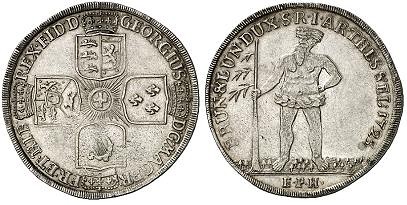
The major users of wildman coin designs are German states, particularly the Brunswick/Braunschweig divisions. The attached wildman taler picture is, by far, the most common design from pfennigs thru multiple talers. The designs from 1540 to 1600 had much more variety than from 1600 to 1799. Wildmen, sometimes a wildman and a wild woman, are frequently used as shield supporters. Issuers of wildman coins and medals include various German states, Belgium, the Netherlands, France, Great Britain, Denmark, Finland, Greece including Crete, and Switzerland. A figure on the “old” coat of arms of the New Orleans Mardi Gras Krewe of Rex is, arguably, a wildman.
I still haven’t found, and maybe there doesn’t exist, a reference file or book that illustrates all the designs to clearly show what coins of the German city of Erfurt include a wildman. The city museum of Erfurt, with my poor German, was not much help, probably because most of the coins are rare and expensive. “Supported shield” in the "SC of German Coins" probably, but not definitively, indicates one or more wildmen.
THE BOOK BAZARRE
QUERY: 1768 ROYAL ACADEMY MEDAL DESIGN SOURCE SOUGHT
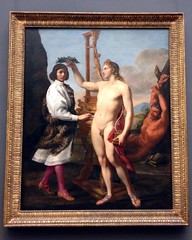

I was in the Metropolitan Museum of Art in New York a few weeks ago and stumbled on a painting by Andrea Sacchi (c.1599-1691) that I recognized as the design source for the 1750 medal by Richard Yeo for the Academy of Ancient Music. I vaguely recalled the Medallic Illustrations listing of the medal (MI 657/362), noting that the device was copied from a Sacchi picture, but wasn’t familiar with the painting or know that it was in an American museum.
Hawkins identifies this painting as “Apollo rewarding Merit and punishing Arrogance”, though the Met uses the title “Marcantonio Pasqualini (1614-1691) Crowned by Apollo”. Whatever one might think of Dick Johnson’s article in the current edition of the TAMS Journal on “art medals” versus “token medals”, I believe that most would agree this particular medal qualifies as an art medal!
 So here’s my question: Does anyone know of a similar fine art or earlier numismatic source for the reverse device of this 1768 Royal Academy medal by Thomas Pingo, showing a youth with Athena who is pointing to a temple on a hilltop? This device was used on many school award medals from about this period onward, and I’ve been trying to find the original source for a while. Having stumbled on the design source of the Yeo medal, I suspect there is a similar source for this youth-with-Athena-pointing-to-temple design.
So here’s my question: Does anyone know of a similar fine art or earlier numismatic source for the reverse device of this 1768 Royal Academy medal by Thomas Pingo, showing a youth with Athena who is pointing to a temple on a hilltop? This device was used on many school award medals from about this period onward, and I’ve been trying to find the original source for a while. Having stumbled on the design source of the Yeo medal, I suspect there is a similar source for this youth-with-Athena-pointing-to-temple design.
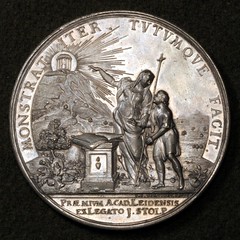 Both Laurence Brown (BHM 132) and Chris Eimer (Eimer 723, Eimer Pingo 42) identify the design for this Royal Academy medal as being by Giovanni Cipriani and Edward Penny. Their design would appear to be the for the specific execution, though, since a University of Leiden Stolp Prize medal from the 1750’s has a very similar design by Frans van Meiris, with Fides rather than Athena. There is an even earlier 1654 Dutch medal by Pieter van Abeele showing a young William III, where Athena is pointing to the heavens (God). A similar French medal showing Athena guiding a young King Louis XV is dated 1717, but I believe that medal was actually made more like 1770.
Both Laurence Brown (BHM 132) and Chris Eimer (Eimer 723, Eimer Pingo 42) identify the design for this Royal Academy medal as being by Giovanni Cipriani and Edward Penny. Their design would appear to be the for the specific execution, though, since a University of Leiden Stolp Prize medal from the 1750’s has a very similar design by Frans van Meiris, with Fides rather than Athena. There is an even earlier 1654 Dutch medal by Pieter van Abeele showing a young William III, where Athena is pointing to the heavens (God). A similar French medal showing Athena guiding a young King Louis XV is dated 1717, but I believe that medal was actually made more like 1770.
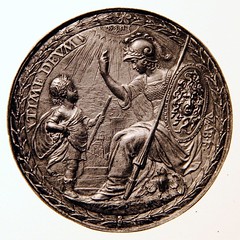

The Athena device originated in ancient times, of course, and there are countless seated and standing Athena/Minerva figures on both fine art and numismatic items going back to the Classical Age. But I’d appreciate help finding any earlier and possibly original inspiration for this youth-with-Athena-pointing-to-temple design used by the Royal Academy in 1768 and more broadly after that.
J. V. MCDERMOTT AND HIS 1913 LIBERTY HEAD NICKEL
I took several numismatic books with me to read on vacation, as it seems I am always behind in my reading. The first one I started is Million Dollar Nickels, the story of the 1913 Liberty Head nickels. I really have been enjoying it. I came to the part where former owners are discussed. When I came to the name of J. V. McDermott it brought back memories.
I first subscribed to the Numismatic Scrapbook Magazine around 1953 or 54. McDermott always was the first advertiser listed. He usually had a five or six page ad. I started to buy coins from him with money I made from my paper route. I did not have a checking account at that time, so my mother had to write a check to pay for the coins.
She was not happy sending checks to Mac's address, which was always "care of general delivery" where ever he happened to be at the time. He was in South Milwaukee in the summer, then made his way to Texas, then Arizona as it got colder.
Mac later sent me a photo of his 1913 nickel, and wrote on it, "Don't try to spend this one, Mac"
I wonder if some of our readers have memories of this colorful dealer and his famous nickel.
DAVID RITTENHOUSE PRESIDENTIAL APPOINTMENT DOCUMENT
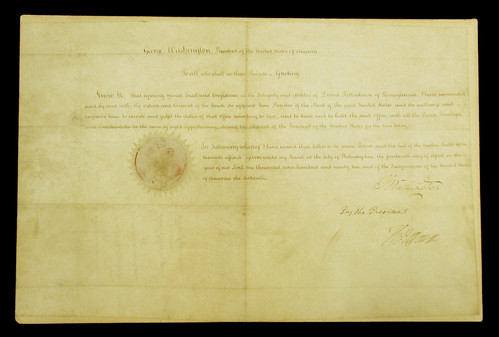
The handwritten document dated April 14, 1792, appointing astronomer, clock maker, inventor and mathematician Rittenhouse as the first Mint Director was signed by President George Washington and Secretary of State Thomas Jefferson. It reads:
George Washington, President of the United States of America
To all who shall see these Presents -- Greeting
Know Ye, That reposing special Trust and Confidence in the Integrity and Abilities of David Rittenhouse of Pennsylvania, I have nominated and by and with Advice and Consent of the Senate do appoint him Director of the Mint of the said United States, and do authorize and empower him to execute and fulfill the duties of that Office according to law, and to have and to hold the said Office with all the Powers, Privileges, and emoluments to the same of right appertaining during the pleasure of the President of the United States for the time being.
In Testimony whereof I have caused these letters to be made Patent, and the Seal of the United States to be hereunto affixed. Given under my Hand, at the City of Philadelphia, the fourteenth day of April in the year of our Lord one thousand seven hundred and ninety two, and of the Independence of the United States of America the Sixteenth.
Go Washington
By the President Th Jefferson
To read the complete article, see: (news.coinupdate.com/david-rittenhouses-presidential-appointment-and-1792-half-disme-at-ana-worlds-fair-of-money-2049/)
U.S. MINT EMPLOYEE RITTENHOUSE MEDALS
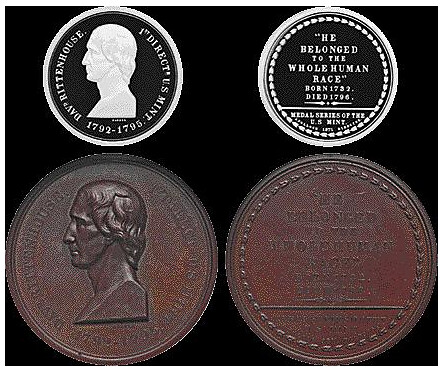
To reward excellence within the ranks of the United States Mint, the nation’s coin producer recognizes achievements with the presentation of the Rittenhouse Medal of Excellence.
The medal replicates the designs that first appeared on Chief Engraver William Barber’s 1871 medal depicting David Rittenhouse, who served from 1792 to 1795 as the first director of the Mint.
For 2013, the U.S. Mint recognized 33 Mint employees June 12 with what is now the bureau’s highest honor, for sustaining “a superior record of performance that significantly furthered and ultimately improved the bureau’s programs, operations and services.”
Since the 2008 inception of the silver Rittenhouse Medal of Excellence, 156 such medals have been awarded.
The Rittenhouse silver award medals are struck at the Philadelphia Mint three times on a Gräbener GMP 360 press with dies oriented to strike with vertical motion.
The striking pressure for each of the three strikes is 202 metric tons.
Barber’s original Rittenhouse medals were produced at the Philadelphia Mint in 45-millimeter “bronze” and silver versions, and dated 1871. The new award medals are also dated 1871. It is unclear today why the original medals were made, though it is likely they were produced for sales to collectors, like many other Mint products of the late 19th century.
To read the complete article, see: U.S. Mint employee award named for first Mint director (www.coinworld.com/Articles/ViewArticle/u-s-mint-employee-award-named-for-first-mint)
QUERY: KENTUCKY HORSESHOE TOKEN INFORMATION SOUGHT
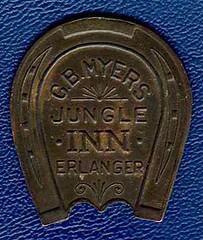
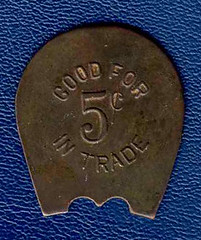
One of my granddaughters found the attached token laying in the dirt at our home here in Blairsville, Georgia. The token seems to be copper or bronze and is thinner than a one-cent piece. It is not magnetic.
The city is Erlanger, which I assume is Kentucky. I could not find any other city in the U.S. by that name. The business name is; Jungle Inn. I could not find a motel by that name. Since it is in the shape of a horseshoe, I assume the business was a motel near the horse park in Erlanger, Ky. This is one of the locations where Pete Rose did a lot of his betting.
The token is valued at five cents in trade. The shape of the five and the value of five cents leads me to believe the token dates from before the 1960s. Any help with information would be greatly appreciated.
Now for the real mystery. How did this token get from just south of Cincinnati, Ohio to seventy-five miles north of Atlanta, Georgia? Who lost it and when?
PETER IRION ON TOKEN AND MEDAL BOOKS YET TO BE PUBLISHED
Greetings from your TAMS Library. This month I would like to ask our membership about your thoughts on the books and catalogs that have NOT YET been published. There are probably millions of tokens and medals that have already been cataloged in some reference book or another, but just as likely there are probably millions of tokens and medals that have never been cataloged anywhere. For example, there are at least 25 catalogs on United States Trade tokens listed by their state of issue. This means that possibly 25 states do not yet have a token catalog written about their tokens. Is there a strong need for all 50 states to have their own reference books? I’d like to hear your thoughts.
From what I see based upon the requests for information that I get from fellow TAMS members or the general public via our website, there is a significant interest from people wanting to know more about modern medals – items that have been made in the past 50 years or so. It is interesting to note that there are really very few books that attempt to catalog anything modern. For example, the last catalog I know about for the Franklin Mint-issued items was a guidebook published in 1982. The Medallic Art Company (and it’s various successors) have issued thousands of medals during the past 100 years, but I am not aware of a single comprehensive catalog on these issues. Maybe Dick Johnson can point us in the right direction here. Even the U.S. Mint has issued hundreds of modern medals, but the last comprehensive catalog on modern U.S. Mint medals was published in 1969 I think.
There are hundreds of other types of tokens and medals that have not yet been cataloged anywhere. I know many authors have plans to write catalogs (or are looking for funding to support their efforts). It is not inexpensive to publish a new catalog nowadays. TAMS often gets offers or requests from members to help publish their book projects. We seriously look at each and every offer, and we try to determine if the book is “saleable” – which means can we make money on it or even break even. It would be great to have a crystal ball to tell us which books will have the greatest interest amongst our membership. Believe it or not, some of the books that TAMS has published sell out well, and other books we still have cases of in storage and we only sell a few of those books every year.
For more information on the Token and Medal Society, see: www.tokenandmedal.org
DICK JOHNSON ON TOKEN AND MEDAL BOOKS YET TO BE PUBLISHED
First, I caution Peter Irion in his casual statement "millions of tokens and medals." I suspect there are not that many different tokens and medals -- in the aggregate-- made in America. The total amount of tokens and medals -- of all kinds, that is, the total press runs of every different token and medal (with the exception of transportation tokens) is probably less than the total press runs of ONE DAY's output of coins at the U.S. Mints.
There is far greater rarity in tokens and medals than in coins. That fact coupled with the great diversity of T and M (are you tired of dates and mintmarks on coins of the same old designs yet?) -- you can grasp the appeal of this collecting field. If you can overcome the characteristic you are collecting coins, as MONEY, you might be tempted to collect T and M. There are pleasures in both camps, of course, but tell me why so many longtime collectors turn from coins to T and M?
Second, I am well into the listing of the medals for the book, a History of Medallic Art Company. I must cut off this list after the great outpouring of the American Bicentennial era (to fit in one book). I had record of 6,121 catalog numbers for the period 1906 thru 1976. This included one number for a series or a medal of several design varieties. My count this week if you add these in was a total of 6,995. I am certain by press time we will discover a few others that will certainly push this number over 7,000.
Also this week you may have read Jeff Shevlin was snapped up by Medallic Art / Northwest Territorial Mint after ANA in their collective wisdom thought he was dispensable. One of Jeff's special projects will be assisting me in work on this history of the firm. In addition, a previous company official, Rob Vugteveen, has returned to the firm so how I have two very capable associates in this project. (If you were at the 2011 Boston ANA you may have met Rob at the MACO / Signature Art Medal bourse display.)
Third, there are far more publishing opportunities in the token and medal fields than in coins, as Peter Irion suggested in his TAMS Journal Bookshelf column. Numismatists can make a significant contribution to the field by writing up a specialized collection and getting this published. Also your name will live forever associated with that specialized topic, like Julian is associated with 19th century US Mint medals. This holds true for both tokens as well as medals.
Tokens. There are 64 token topic fields discussed in Steve Alpert and Larry Elman's book Token and Medals. Each of these token topics is given a chapter in their book This book should be in every numismatist's library. It is still available and viable despite its 1992 date. (I ranked it at number 14 greatest work NOT on the List of Suggested Titles in the NBS Survey of the 100 greatest numismatic books).
Of the 64 topics 23 had NOT ONE reference work listed. Here are the unpublished token topics:
- Admission Passes & Tokens
- Advertising & Business Anniversary T and M
- Apothecary Weights
- Banks
- Calendars
- Coin Replicas
- Dog License Tags
- Encased Coins
- Flippers
- Movie Money
- Numismatic
- Relic "Made From" Items
- Religion
- Soap & Store Coupon Tokens
- Souvenir From Tourist Spots
- Souvenir & Commemorative Trade Items
- Spinners
- Swastika
- Tags
- Token Makers
- Vending & Meter Tokens
- Western & Gold Related Items
- Wooden Money
Many of the topics have numerous sub -topics. Entertainment, for example. has nine sub-topics each of which deserves a specialized catalog. Only one, Magician items, has a published reference.
Medals. I once compiled a list of medal topics and came up with 350 major topics. Of those only 14 had a published book. So Peter Irion is very much right, in that the field of tokens and medals is much in need of specialized catalogs.
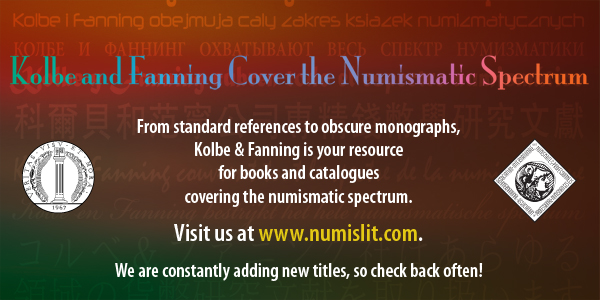
DAVID O'KEEFE AND YAP STONE MONEY
Yap money was most certainly bartered. Just read the story of David O'Keefe who discovered that the best way to motivate the Yapese men to harvest copra was to trade the stones for labor. Using modern tools and transportation, O'Keefe imported so many stones that their value plummeted on the island.
For a more romanticised version of this story, watch "His Majesty O'Keefe," a 1954 movie starring Burt Lancaster. It's pretty heavy on the testosterone, but it shows the effect of his trading enterprise.
I became fascinated by Yap money years ago in discussions with Chuck Opitz, who visited Yap with his wife. Later, PCGS purchased a small stone that remains on display in our library. Size is relative, of course; we call it simultaneously "spare change" because it is a small stone, and "the only coin PCGS won't encapsulate" because it is too large.
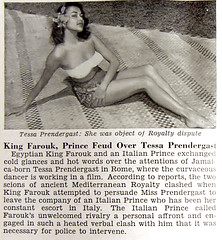 One of the stars of "His Majesty O'Keefe," and the object of Burt Lancaster's attention in the film, was the Jamaican beauty Tessa Prendergast. Apparently, she also caught the eye of our own King Farouk in real life!
http://www.flickr.com/photos/vieilles_annonces/1217937350/
One of the stars of "His Majesty O'Keefe," and the object of Burt Lancaster's attention in the film, was the Jamaican beauty Tessa Prendergast. Apparently, she also caught the eye of our own King Farouk in real life!
http://www.flickr.com/photos/vieilles_annonces/1217937350/
According to imdb.com, "Tessa Welborn [born Marie Therese Prendergast] was the designer responsible for the bikini worn by Ursula Andress in the film Dr. No" ( www.imdb.com/name/nm0695973/bio). Thus Bo Derek is connected to Yap stones . . . how?
To read the complete O'Keefe article, see: David O’Keefe: The King of Hard Currency (blogs.smithsonianmag.com/history/2011/07/david-okeefe-the-king-of-hard-currency/)
To read the earlier E-Sylum article, see: BOOK REVIEW: MONEY: THE UNAUTHORISED BIOGRAPHY (www.coinbooks.org/esylum_v16n27a08.html)
FAIRBANKS, ALASKA CARNIVAL MONEY
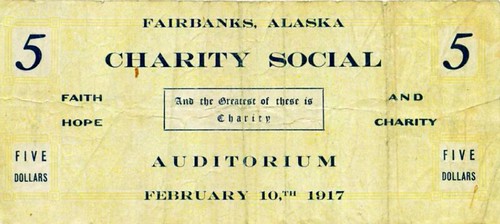
1917 Fairbanks Charity Social note
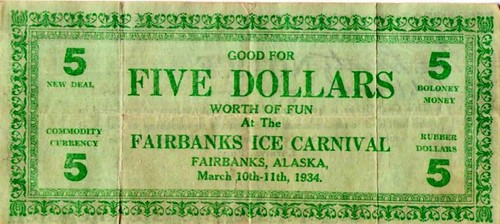
1934 Fairbanks Ice Carnival note
Dick Hansom writes:
These are truly rare items as they were only good for one or two nights. Since they were paper, they were highly degradable and disposable. That any survived is quite surprising.
THE DANDELION DOLLAR
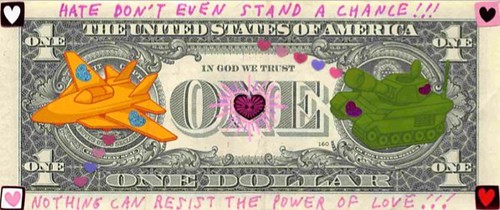
Someone sent this dollar bill to my attention at Make magazine. The front of the bill had a URL for a video. I'm giving it to my daughter to pin on her cork board.
Dandelion Dollars promotes the spiritual practice of sending off dandelion seeds of LOVE, JOY, and HOPE into the world using the paper currency system to deliver them to all humanity. All you need is a dollar, a pen, a minute, and a message!
To read the complete article, see: My Dandelion Dollar (boingboing.net/2013/07/02/my-dandelion-dollar.html)
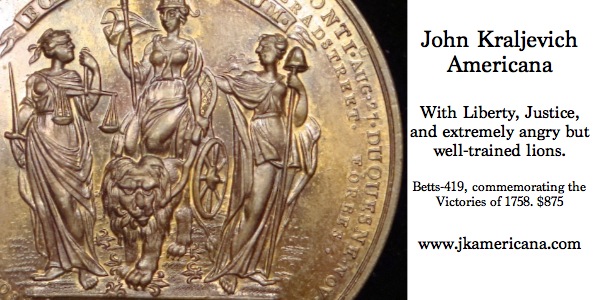
THE FORT SUMTER GILLMORE MEDAL
Nick Graver writes:
I just received the monthly New York - Pennsylvania Collector, and the first article to catch my eye has to be mentioned for E-Sylum consideration.
General Quincy Gillmore had 400 very interesting medals struck by the New York firm of Ball, Black, and Co. which he awarded to his men for their performance in his campaign to take Fort Sumter, Charleston, SC 8/23/63.
John Sexton, in his regular column, "The Civil War Collector" tells the story and shows both the writer's medal (missing the hanger) and a complete one.
I have recently come across this medal from Fort Sumter. I am looking to sell this piece. You were recommended to me by a lady from the Drummer Boy Museum of Georgia. How much do you think that a piece like this could go for?
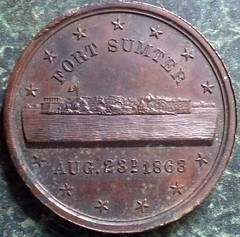
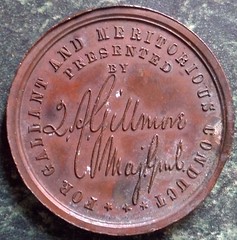
J.S.: Your medal is a scarce Civil War medal awarded by General Quincy Gillmore to certain soldiers in his command and known as the "Gillmore Medal." The medal's obverse is captioned, "Fort Sumter / August 23d 1863" and shows the once formidable structure reduced to rubble after several days of well-directed federal bombardment. Interestingly for a Union medal, high magnification reveals the Confederate national colors still flying defiantly above Sumter's battered ramparts.
The reverse perimeter legend, "For Gallant and Meritorious Conduct," encircles a central proclamation reading, "Presented by Q. A. Gillmore Maj. Genl." A military engineer trained at West Point, Major General Quincy Adams Gillmore made a gallant effort to capture Charleston, South Carolina. To achieve that goal, he tried neutralizing the city's defenses with all of the considerable firepower at his disposal. The courage and devotion to duty demonstrated by Gillmore's men were not unnoticed, and the general had some 400 medals for valor privately issued under his own name by the New York firm of Ball, Black & Co.
Unfortunately, your medal is missing the top bar (which is attached by a claw-type catch) that had the inscription with soldier's name. I have seen several of these medals missing this part before, and they are typically priced about $500-$1,000.
The last complete medal I know of was sold by Leland Little Auction Company in Hillsborough, N.C., Sept 17, 2011 for $3,200. Their medal pictured here shows a complete top bar with the name inscribed, "G. E. Hazen, 3rd Rhode Island Artillery." These medals in past have sold for more than $5,000, based on the soldier's history.
To read the complete article, see: Ask the Civil War Collector (www.go-star.com/antiquing/civil_war_collector_0713.htm)
For more information on Southeastern Antiquing Magazine, see: www.antiquingmagazine.com
THE 1864 STONEWALL JACKSON MEDAL
Stonewall Jackson Medal of 1864
By Gerard Muhl, RNA President - 1979

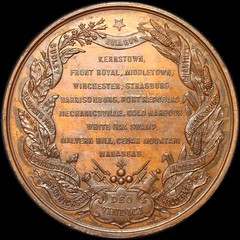
A privately commissioned medal commemorates the Civil War actions of General Thomas Jonathon "Stonewall" Jackson. The medal is two inches in diameter and is struck in white metal. It shows a heroic bust of Jackson facing left and the date of his birth, 1821, and the date of his death at age 39 in 1863. The 1821 birth date is wrong as he actually was born in 1824.
Jackson served with great merit in the Shenandoah Valley Campaign of 1862, until the time he was accidentally shot by his own troops in May 1863.
The reverse of the medal shows a corn and tobacco wreath and the battles Jackson fought. At the base of the list among the images of cannons, swords, and bayonets is a Latin inscription meaning "Claimed by God".
Charles A. Lamar commissioned the Jackson medals to be struck. Beginning in 1858 he became actively involved in the Atlantic slave trade - making trips be-tween West Africa and Jekyll Island. The U.S. and Great Britain had both outlawed the international slave trade in 1808. Lamar thus had to slip through the British Atlantic blockade to get his human cargo to America. Funds from the slave trade al-lowed Lamar's bank in Savannah to thrive. All this changed in 1862 with the outbreak of the War.
Lamar commissioned Armand Caque to design and have the Stonewall medal struck. Caque was engraver to the Emperor of France, Napoleon III.
Before seeing the medal, of which perhaps 500 were struck, Charles Lamar was killed in action in Georgia.
The medals were turned over to Lamar's widow who kept them sequestered in a Savannah cotton ware-house. There they remained for over twenty-five years when they were given to the Ladies Auxiliary of the Confederate Veterans association. They sold for one dollar each to benefit wounded veterans of the South.
It has been estimated that between 200 and 300 medals still exist though many show nicks and scratches and substantial wear from rough handling.
For more information about the Rochester Numismatic Association, see: www.the-rna.com
THE FERRACUTE MACHINE COMPANY

The Ferracute Machine Company in Bridgeton, New Jersey was founded by Oberlin Smith in 1863. In its beginning as a machine shop it went on to making metal forming presses. The presses first were made to produce cans. When the automobile industry took root the presses were designed to make car parts for Ford, Packard, Cadillac and others.
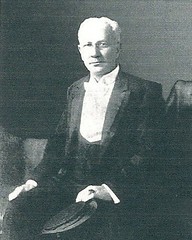 Oberlin Smith was always creative in what his machines could expand upon. He often traveled to Europe to explore new opportunities. With an idea that he could design a coin press he began to make demonstration pieces. Shortly afterwards the United States Mint became a customer purchasing some of his coin presses. In 1898 the company sold three coin presses to the Imperial Chinese Mint.
Oberlin Smith was always creative in what his machines could expand upon. He often traveled to Europe to explore new opportunities. With an idea that he could design a coin press he began to make demonstration pieces. Shortly afterwards the United States Mint became a customer purchasing some of his coin presses. In 1898 the company sold three coin presses to the Imperial Chinese Mint.
During the Great Depression, The Ferracute Machine Company was sold. George Bass purchased the company with hopes of becoming a major producer of presses that would make machine tools and airplane parts. On the brink of World War II, the U.S. Government became the largest customer. The Soviet Union along with Great Britain also purchased presses to help with their war needs. After the war, the company went into decline closing their doors in 1968.
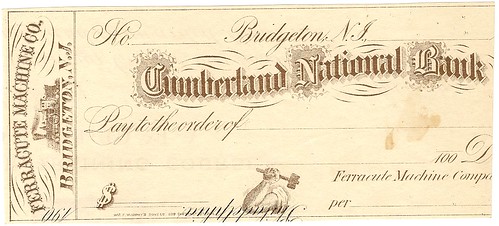
Ferracute Machine Company check
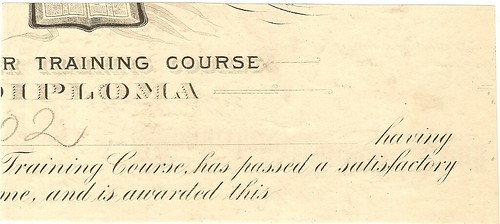
Check back: a Philadelphia training course diploma
In the Numismatic News March 25th, 2003 edition an unusual check, never used, was intended for The Ferracute Machine Co. of Bridgeton, N.J. drawn on Cumberland National Bank, and printed in brown ink on the back of a Philadelphia training course diploma. Vignettes include a locomotive and arm-in-hammer. The specimen has it's right edge cut off. Originally from the Robert Ulrich collection who lived in Bridgeton, N.J. was acquired by James Henderson in 2002. It has now been in the John Linhoss collection since 2004.
These three examples of demonstration pieces are in the John Linhoss collection.

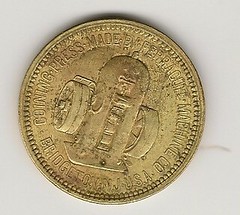
The largest example of the tokens are of two pug dogs on the obverse and the coin press on the reverse. It is listed in Rulau, NJ-Brg-6. Circa 1900. 38mm, Brass.
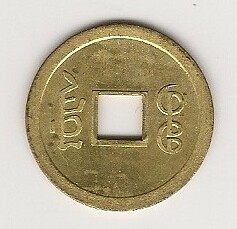
The Chinese example is of a coin that was never issued or found in Krause. 23mm, Brass.

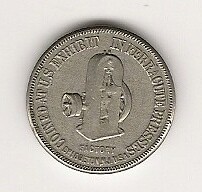
The Paris Exposition Internationale, dated 1900 has the U.S. pavilion on the obverse and the coin press on the reverse. It is listed in Rulau, NJ-Brg-4. 19mm, Nickel.
THE BOOK BAZARRE
ERIC THE RED LIFESAVING MEDAL ON DISPLAY IN WARRNAMBOOL
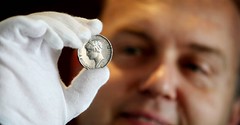 A RARE medal awarded by the president of the United States to rescuers of an American ship off the south-west Victorian coast more than 130 years ago has been donated to Warrnambool.
A RARE medal awarded by the president of the United States to rescuers of an American ship off the south-west Victorian coast more than 130 years ago has been donated to Warrnambool.
It will go on permanent display at Flagstaff Hill Maritime Village, along with other memorabilia from the Eric the Red shipping disaster.
The medal was awarded to the crew of the Warrnambool steamer SS Dawn, who rescued survivors of the ship which struck a reef off Cape Otway in 1880 while carrying cargo to Melbourne for an international exhibition.
Four people on the US vessel drowned and the 23 survivors were taken to Warrnambool to recover.
Later the US government expressed its appreciation to the Warrnambool community, saying “the city hosted and supported the crew most graciously”.
The family of one of the former SS Dawn crew members approached Flagstaff Hill, offering to donate the bravery medal.
“We received the medal this week and will look to display this rare item with artefacts we have from the Eric the Red wreck that are in storage,” maritime village manager Peter Abbott said.
“We’ve got a door and part of the wheel from the wreckage.”
Heritage Victoria has listed Eric the Red as one of the state’s most significant 19th century shipwrecks.
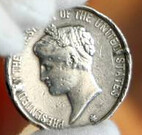 Interesting! I wish we had a better image of the obverse, or any image at all of the reverse. This appears to be an example of an 1880 State Department medal, cataloged as LS-3 (page 322) of R. W. Julian's book, Medals of the United States Mint: The First Century 1792-1892. The reverse is mostly blank for engraving, surrounded with a thin wreath. It was designed by George Morgan and struck in gold, silver and bronze. The one pictured here appears to be silver.
Can anyone tell us more about these, or the awarding of this particular example?
Thanks.
-Editor
Interesting! I wish we had a better image of the obverse, or any image at all of the reverse. This appears to be an example of an 1880 State Department medal, cataloged as LS-3 (page 322) of R. W. Julian's book, Medals of the United States Mint: The First Century 1792-1892. The reverse is mostly blank for engraving, surrounded with a thin wreath. It was designed by George Morgan and struck in gold, silver and bronze. The one pictured here appears to be silver.
Can anyone tell us more about these, or the awarding of this particular example?
Thanks.
-Editor
To read the complete article, see: US president’s reward to south-west shipwreck heroes (www.standard.net.au/story/1609344/us-presidents-reward-to-south-west-shipwreck-heroes/)
To read the earlier E-Sylum articles, see:
TOKENS OF WILLIAM BATEMAN OF WARRNAMBOOL, AUSTRALIA
(www.coinbooks.org/esylum_v16n26a22.html)
AN AUSTRALIAN MAN'S SHOCKING STATIC JACKET
(www.coinbooks.org/esylum_v16n25a26.html)
NANOTECHNOLOGY BRINGS BUTTERFLY COLORS TO CURRENCY
 For more than a decade, I’ve been fascinated by biomimicry, the way engineers take cues from animals to make airplanes fly faster or submarines glide more efficiently.
For more than a decade, I’ve been fascinated by biomimicry, the way engineers take cues from animals to make airplanes fly faster or submarines glide more efficiently.
In Vancouver, British Columbia, we found one of the most advanced biomimicry yet, with some seriously money-saving ways it can be used.
Every year in the U.S., about $270 million in counterfeit cash is seized by the government. That’s a tiny fraction of the $300 billion in fake money believed to circulate domestically each year. But it’s a growing problem. As scanning and printing technology advance, officials with the U.S. Secret Service say the potential for counterfeiting is rising, especially for big denominations like $50 and $100 bills. Governments abroad are also concerned; they often have less advanced money-printing techniques and less regulation over fake bills.
Enter the Blue Morpho butterfly: a species with unique qualities that might hold the clue for fighting counterfeiting.
The Morpho has a stunning metallic blue color, but it’s not made from the usual ways colors are formed in nature, through pigments or dyes. Instead its color comes from structural patterns—tiny patterns of microscopic holes that reflect blue light to our eyes.
We stopped in at NanoTech Security, a company trying to recreate those microscopic hole patterns to use on currency of the future. Instead of printing images with ink on paper, the idea is to press a pattern of tiny holes that would reflect a certain pattern. It would be virtually impossible to counterfeit without some advanced equipment and a clean room with fewer than 100 parts per million of floating particulates (most public places have more than one million parts per million).
To read the complete article, see: The Butterfly Effect: How Blue Morpho Wings Could Stop Counterfeiting (newswatch.nationalgeographic.com/2013/06/30/the-butterfly-effect-how-blue-morpho-wings-could-stop-counterfeiting/)
ARTICLE PROFILES CANADIAN COIN DESIGNER JOHN HORTON
 One of Canada’s most notable marine artists has produced two more commemorative coins for the Royal Canadian Mint.
One of Canada’s most notable marine artists has produced two more commemorative coins for the Royal Canadian Mint.
Tsawwassen’s John Horton sketched the design for the coins after the Mint put out a request for submissions earlier in the year.
The first coin is 40mm in diameter and commemorates the 300th Anniversary of the French Fortress of Louisbourg, a National Historic Site of Canada located on Cape Breton Island.
The second one depicts a naval battle between the HMS Shannon and the USS Chesapeake during the War of 1812. The Battle of Boston Harbor was actually fought on June 1, 1813, during which time the American ship was captured and 252 men killed or wounded in a bloody 15-minute-long cannon battle between the powerful frigates.
“They’re fun to do,” said Horton about sketching the coin designs. “They’re really challenging because you’re sometimes dealing with history you don’t know too much about. The fun part is researching the history.”
As a Western artist he said he’s more familiar with the naval history of this region. His series of paintings depicting Captain George Vancouver’s voyages from 1792-94 are world renowned.
In 1996 Horton won a bid to sketch a design for the Tall Ships Collection and his artwork “the catch” appears on one of the coins in that collection.
A fourth coin for the Mint is now in the works for release in 2014, but for reasons of confidentiality with the Crown corporation he can’t reveal what it will be.
Horton said it takes roughly three weeks to sketch a design for the Mint, followed by consultations and tweaking for the final product.
To read the complete article, see: Local artist’s work adorns Canadian Mint’s new coin (www.southdeltaleader.com/community/214306921.html)

ROYAL MINT TO ISSUE SILVER PENNY FOR ROYAL BIRTH
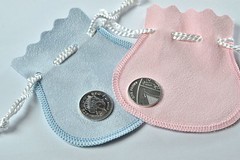 Babies born on the same day as William and Kate’s first child will be sent a “lucky” silver penny to celebrate the royal arrival.
Babies born on the same day as William and Kate’s first child will be sent a “lucky” silver penny to celebrate the royal arrival.
The coins, presented in blue or pink pouches, will be struck with the year and 2,013 of them will be made.
A teddy bear card will read: “Solid sterling silver good luck penny.”
The Duchess of Cambridge is thought to be due on July 13 and is set to give birth to the future monarch at St Mary’s Hospital, Paddington, Central London, where William was born in 1982.
Shane Bissett, of currency-maker the Royal Mint, said: “The birth will be a joyous occasion for the whole nation.
“It will also be a special day for many mothers and fathers across the country as they, too, welcome their new baby.”
Crossing the palm of a newborn with silver is seen as a way of wishing them wealth and good health.
The penny shows a shield of the Royal Arms, with the three lions, the Scots lion rampant and Irish harp.
Almost 2,000 babies are born each day in the UK.
Parents have 60 days after the birth to claim the coin on the Royal Mint’s Facebook page.
To read the complete article, see: Kate Middleton baby's birth marked with "lucky" silver penny given to all others born on same day (www.mirror.co.uk/news/uk-news/kate-middleton-babys-birth-marked-2024376)
SCOTTISH FESTIVAL CLEANUP CREW FINDS COIN HOARD
A Roman coin hoard has been found at the site of a major Highland music festival, it has emerged.
Some of the 36 denarii were discovered by Eric Soane using a metal detector during a clean up of discarded tent pegs after last year's Belladrum.
A dig led by archaeologist Dr Fraser Hunter uncovered the rest of what was the first Roman coin hoard to be discovered in the Beauly area.
Some of the coins date from the mid-Second Century.
They will be on permanent display at Inverness Museum and Art Gallery from 16 July.
Festival promoter Joe Gibbs said: "Left-behind tent pegs can be dangerous to stock and can damage machinery.
"We like to get rid of as many as possible. But it was an unexpected bonus to find the coins."
He added: "Heavy metal isn't generally a genre we go in for at Belladrum, but perhaps we should revise that as clearly there is a precedent, albeit 2000 years ago."
To read the complete article, see: Roman coin hoard found at Belladrum festival site (www.bbc.co.uk/news/uk-scotland-highlands-islands-23204839)
SOME NEW COIN DESIGNS: JULY 7, 2013
Pabitra Saha forwarded several new coin images this week, and a few caught my eye. Regarding one from last week, Dave Alexander writes:Labas! (Lithuanian for Hello!) The prickly tangle on the obverse of the Lithuanian 50 Litu is the stylized map of the Euro zone nations and the stars representing member states scrambled together. The 5 Litai coin's wreath is one of the originals of pre-war Lithuania, which employed rye, barley and the national plant the Rue (Lithuanian, Ruta).Ripening fields of rye inspired the yellow band in the nation's flag.
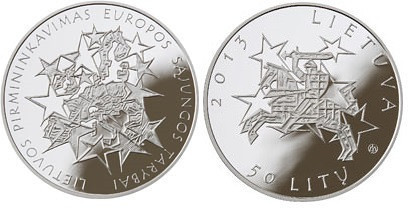
2011 Croatia 25 Kuna
Monday, Pabitra Saha wrote:
Today Croatia has joined the European Union. It had issued this coin on 9th Dec. 2011 when it signed the agreement to join the EU.
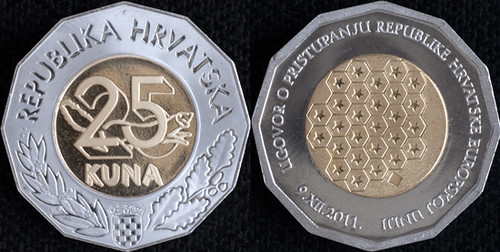
Latvia Jâzeps Vîtols Coin
Pabitra Saha writes:
Latvia has issued a coin on Jâzeps Vîtols, a Latvian composer on his 150th birth anniversary

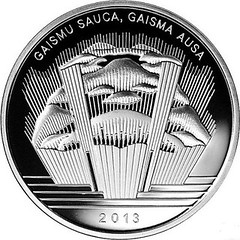
Netherlands Antilles Slavery Abolition Coin
Pabitra Saha writes:
Netherlands Antilles has issued a 5 Guilder coin on 150th Ann of abolition of slavery
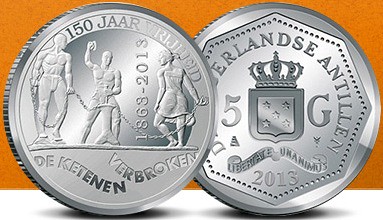
For more information, see: Royal Mint issues special BES-dollar (www.sabanews.nl/0_wordpress/royal-mint-issues-special-bes-dollar/)
First Coins of Caribbean Netherlands
Pabitra Saha writes:
The Caribbean Netherlands ( Bonaire, St. Eustatius and Saba Islands ) have issued their first coin.
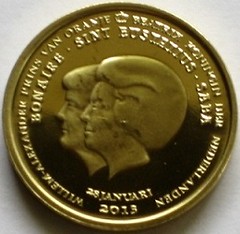
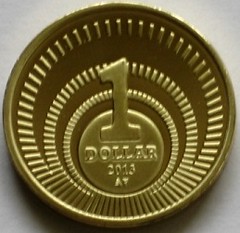
To read the earlier E-Sylum article, see: SOME NEW COIN DESIGNS: JUNE 30, 2013 (www.coinbooks.org/esylum_v16n27a20.html)
DEWEY DECIMAL JEWELRY
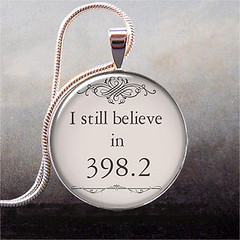 When he developed his decimal system in the 1870s, Melvil Dewey was trying to bring the efficiency and allure of engineering to the emerging field of library science. At a moment when engineers were national heroes, nothing quite said reliable or important like decimals. It’s perhaps ironic, then, that the Dewey Decimal System is today not just a practical way to find books in most public libraries (but not most large research libraries, where the Library of Congress system holds sway). It’s also—and maybe more importantly—a symbol of the romance of libraries, not their efficiency.
When he developed his decimal system in the 1870s, Melvil Dewey was trying to bring the efficiency and allure of engineering to the emerging field of library science. At a moment when engineers were national heroes, nothing quite said reliable or important like decimals. It’s perhaps ironic, then, that the Dewey Decimal System is today not just a practical way to find books in most public libraries (but not most large research libraries, where the Library of Congress system holds sway). It’s also—and maybe more importantly—a symbol of the romance of libraries, not their efficiency.
We can see the particular, fantastical romance of the Dewey Decimal System best in the proliferation of jewelry that says “I still believe in 398.2,” or variations thereof. 398.2 being, of course, the classification for fairy tales (or, in other words, about as far as you can get from engineering).
But if your reading tastes run in a different direction, there are other Dewey Decimal categories to choose your jewelry from. The Written Nerd, for example, uses real card catalog cards to make jewelry under different headings. Like science:

To read the complete article, see: Dewey Decimal jewelry (bookriot.com/2013/06/14/dewey-decimal-jewelry/)
KENYAN PICKPOCKETS PROTEST CASHLESS TRANSACTIONS
Chris Fuccione writes:
This is NOT from The Onion and it is not April 1st today.
Local pickpockets have come out to strongly condemn the shift Kenya is taking towards a cashless society.
At a press conference held in a secret and remote location, the pickpockets criticised the move by financial institutions and mobile phone networks to popularise electronic and mobile money, saying it is robbing them of their means of livelihood.
“Whenever people carry ATM cards and keep money in their SIM cards, it means that whenever we dip our hands into their pockets, we come out empty handed! This is threatening our means of survival must be discouraged in the strongest terms possible,” asserted Yellow Pages, the spokesperson for the pickpockets, so named because his fingers do all the walking in people’s pockets.
Regarding the numerous electronic and mobile money products being introduced into the market, the pickpockets called for a halt in the pace of innovation.
“For all those people with brilliant ideas, this is the time to stop thinking and let the rest of the world overtake you for the sake of our job security!” said Yellow Pages, as he shifted his dark glasses.
To read the complete article, see: Pick pockets oppose cashless transactions (www.standardmedia.co.ke/?articleID=2000082056&story_title=Kenya-pick-pockets-oppose-cashless-transactions)
To read the Numismatic News article, see: Pickpockets Protest Cashless Society (www.numismaster.com/ta/numis/Article.jsp?ad=article&ArticleId=26997&et_mid=626594&rid=238076497)
FEATURED WEB PAGE: DATES ON MODERN SPANISH PESETA COINS
This week's Featured Web Page from the Numista site is about reading the dates on modern Spanish peseta coins. Who knew? Not me!
From 1946 through 1982, the coins of Spain bear two dates, a series date and a mintage date. The series date is often mistaken for the mintage date, and this article was written to correct this misconception.
This practice began in 1946 and continued for 35 years. It was only applied to coins of 50 centimos and higher, and never to 5 and 10 centimo coins.
The series date represents the date in which that particular type of coin was first minted, and it is the more obvious date on the coin. It is typically (but not always) under the portrait on the obverse of the coin, be it General Francisco Franco or King Juan Carlos I. This date will be 1946, 1947, 1949, 1953, 1957, 1963, 1966, 1975, or 1980. Any change to the coin's design, even minor modifications to the portrait or legend, reset the series date to the contemporary year. If the design remained unchanged, the series date remained fixed as well. For example, the five pesetas coin was minted between 1957 and 1974, but all coins minted during that period bear the series date of 1957.
The mintage date represents the year the coin was actually minted, and it is easy to overlook. It appears inscribed inside a six-pointed star that appears typically (but not always) on the reverse of the coin. The numerals of the mintage year are incuse text inside these six-pointed star, the last two digits of the mintage year (such as "68" for 1968). In some series, another star containing the first two digits of the mintage year (always "19") appears as well.
In 1982, the design date was retired, and Spanish coins began bearing only the mintage date, though some coins in 1982 still used the older two-date custom. If the coin bears the logo of the Royal Mint of Spain (a crowned letter "M") where the six-pointed star would be, then the date on the obverse is the mintage date.
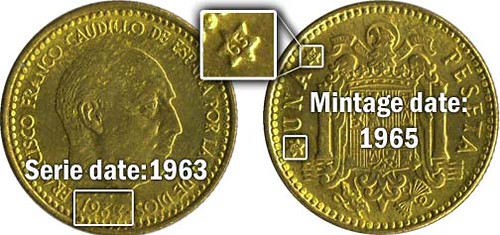
en.numista.com/numisdoc/dates-on-modern-spanish-peseta-coins-61.html
